Engineering Dynamics Homework Solutions and Problem Analysis
VerifiedAdded on 2023/04/21
|8
|1159
|227
Homework Assignment
AI Summary
This document presents solutions to various problems in Engineering Dynamics. It covers topics including the calculation of forces in parallel and series spring systems, determining oscillation periods, and deriving equations of motion for particles under given conditions. The solutions involve applying principles of linear motion, calculating displacement and velocity, and analyzing trajectory equations based on provided figures. The document includes detailed step-by-step solutions, calculations, and relevant formulas, along with references to supporting materials. Specific problems address scenarios with varying initial conditions, forces, and motions, offering a comprehensive approach to solving dynamics problems. The content is useful for students studying mechanical engineering and related fields, providing a valuable resource for understanding and applying the principles of dynamics.
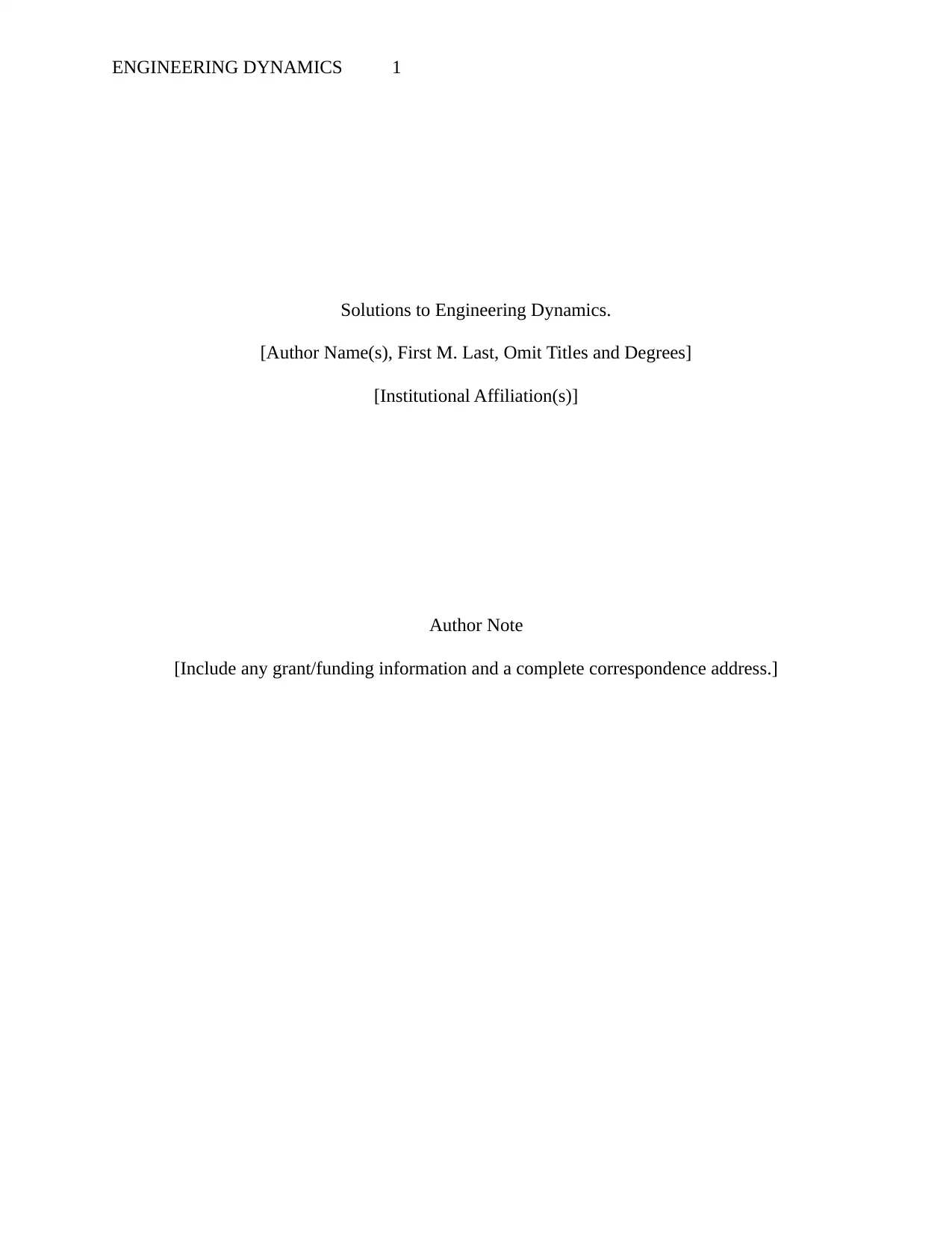
ENGINEERING DYNAMICS 1
Solutions to Engineering Dynamics.
[Author Name(s), First M. Last, Omit Titles and Degrees]
[Institutional Affiliation(s)]
Author Note
[Include any grant/funding information and a complete correspondence address.]
Solutions to Engineering Dynamics.
[Author Name(s), First M. Last, Omit Titles and Degrees]
[Institutional Affiliation(s)]
Author Note
[Include any grant/funding information and a complete correspondence address.]
Paraphrase This Document
Need a fresh take? Get an instant paraphrase of this document with our AI Paraphraser
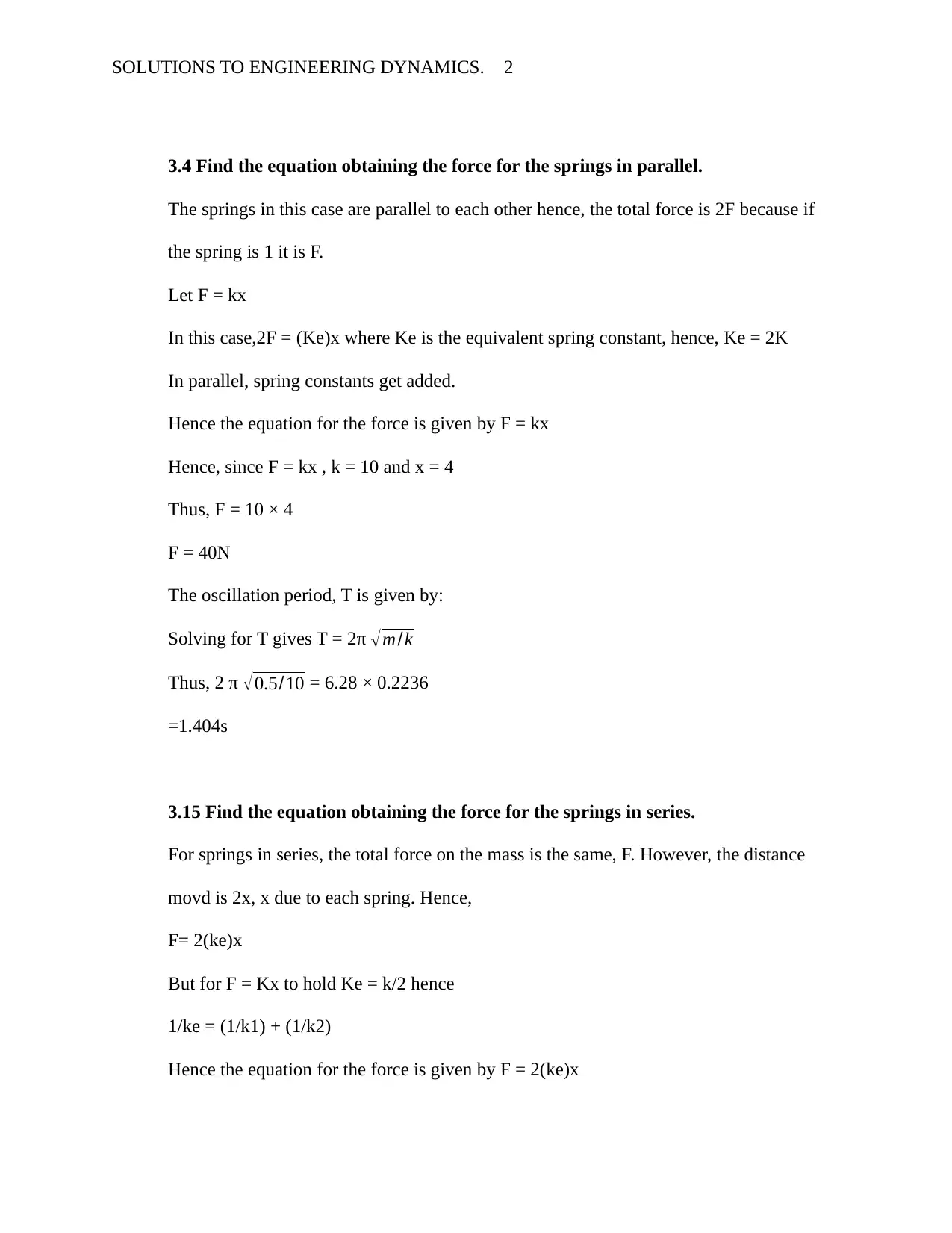
SOLUTIONS TO ENGINEERING DYNAMICS. 2
3.4 Find the equation obtaining the force for the springs in parallel.
The springs in this case are parallel to each other hence, the total force is 2F because if
the spring is 1 it is F.
Let F = kx
In this case,2F = (Ke)x where Ke is the equivalent spring constant, hence, Ke = 2K
In parallel, spring constants get added.
Hence the equation for the force is given by F = kx
Hence, since F = kx , k = 10 and x = 4
Thus, F = 10 × 4
F = 40N
The oscillation period, T is given by:
Solving for T gives T = 2π √m/k
Thus, 2 π √ 0.5/10 = 6.28 × 0.2236
=1.404s
3.15 Find the equation obtaining the force for the springs in series.
For springs in series, the total force on the mass is the same, F. However, the distance
movd is 2x, x due to each spring. Hence,
F= 2(ke)x
But for F = Kx to hold Ke = k/2 hence
1/ke = (1/k1) + (1/k2)
Hence the equation for the force is given by F = 2(ke)x
3.4 Find the equation obtaining the force for the springs in parallel.
The springs in this case are parallel to each other hence, the total force is 2F because if
the spring is 1 it is F.
Let F = kx
In this case,2F = (Ke)x where Ke is the equivalent spring constant, hence, Ke = 2K
In parallel, spring constants get added.
Hence the equation for the force is given by F = kx
Hence, since F = kx , k = 10 and x = 4
Thus, F = 10 × 4
F = 40N
The oscillation period, T is given by:
Solving for T gives T = 2π √m/k
Thus, 2 π √ 0.5/10 = 6.28 × 0.2236
=1.404s
3.15 Find the equation obtaining the force for the springs in series.
For springs in series, the total force on the mass is the same, F. However, the distance
movd is 2x, x due to each spring. Hence,
F= 2(ke)x
But for F = Kx to hold Ke = k/2 hence
1/ke = (1/k1) + (1/k2)
Hence the equation for the force is given by F = 2(ke)x
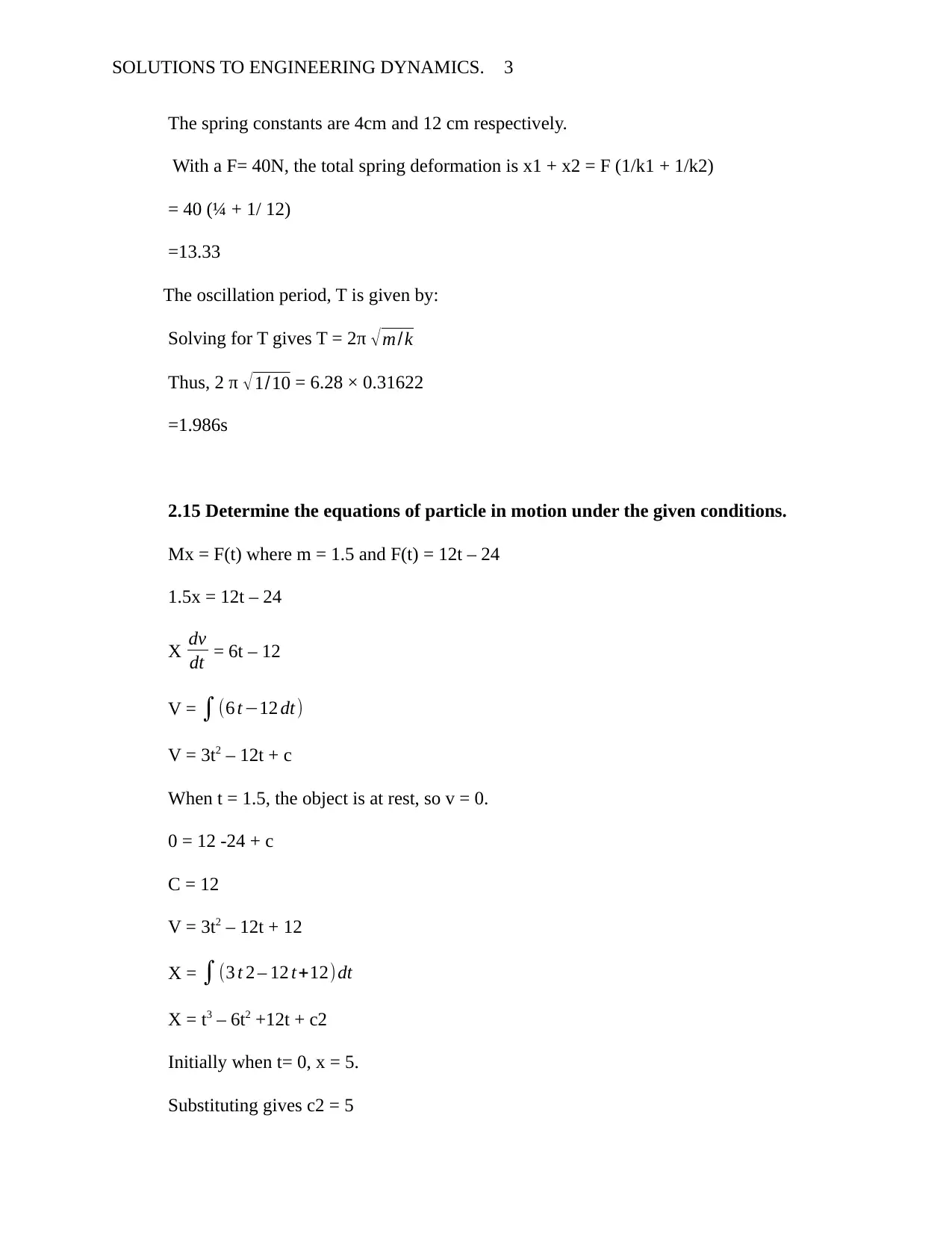
SOLUTIONS TO ENGINEERING DYNAMICS. 3
The spring constants are 4cm and 12 cm respectively.
With a F= 40N, the total spring deformation is x1 + x2 = F (1/k1 + 1/k2)
= 40 (¼ + 1/ 12)
=13.33
The oscillation period, T is given by:
Solving for T gives T = 2π √m/k
Thus, 2 π √1/10 = 6.28 × 0.31622
=1.986s
2.15 Determine the equations of particle in motion under the given conditions.
Mx = F(t) where m = 1.5 and F(t) = 12t – 24
1.5x = 12t – 24
X dv
dt = 6t – 12
V = ∫(6 t−12 dt)
V = 3t2 – 12t + c
When t = 1.5, the object is at rest, so v = 0.
0 = 12 -24 + c
C = 12
V = 3t2 – 12t + 12
X = ∫(3 t 2 – 12 t+12)dt
X = t3 – 6t2 +12t + c2
Initially when t= 0, x = 5.
Substituting gives c2 = 5
The spring constants are 4cm and 12 cm respectively.
With a F= 40N, the total spring deformation is x1 + x2 = F (1/k1 + 1/k2)
= 40 (¼ + 1/ 12)
=13.33
The oscillation period, T is given by:
Solving for T gives T = 2π √m/k
Thus, 2 π √1/10 = 6.28 × 0.31622
=1.986s
2.15 Determine the equations of particle in motion under the given conditions.
Mx = F(t) where m = 1.5 and F(t) = 12t – 24
1.5x = 12t – 24
X dv
dt = 6t – 12
V = ∫(6 t−12 dt)
V = 3t2 – 12t + c
When t = 1.5, the object is at rest, so v = 0.
0 = 12 -24 + c
C = 12
V = 3t2 – 12t + 12
X = ∫(3 t 2 – 12 t+12)dt
X = t3 – 6t2 +12t + c2
Initially when t= 0, x = 5.
Substituting gives c2 = 5
⊘ This is a preview!⊘
Do you want full access?
Subscribe today to unlock all pages.

Trusted by 1+ million students worldwide
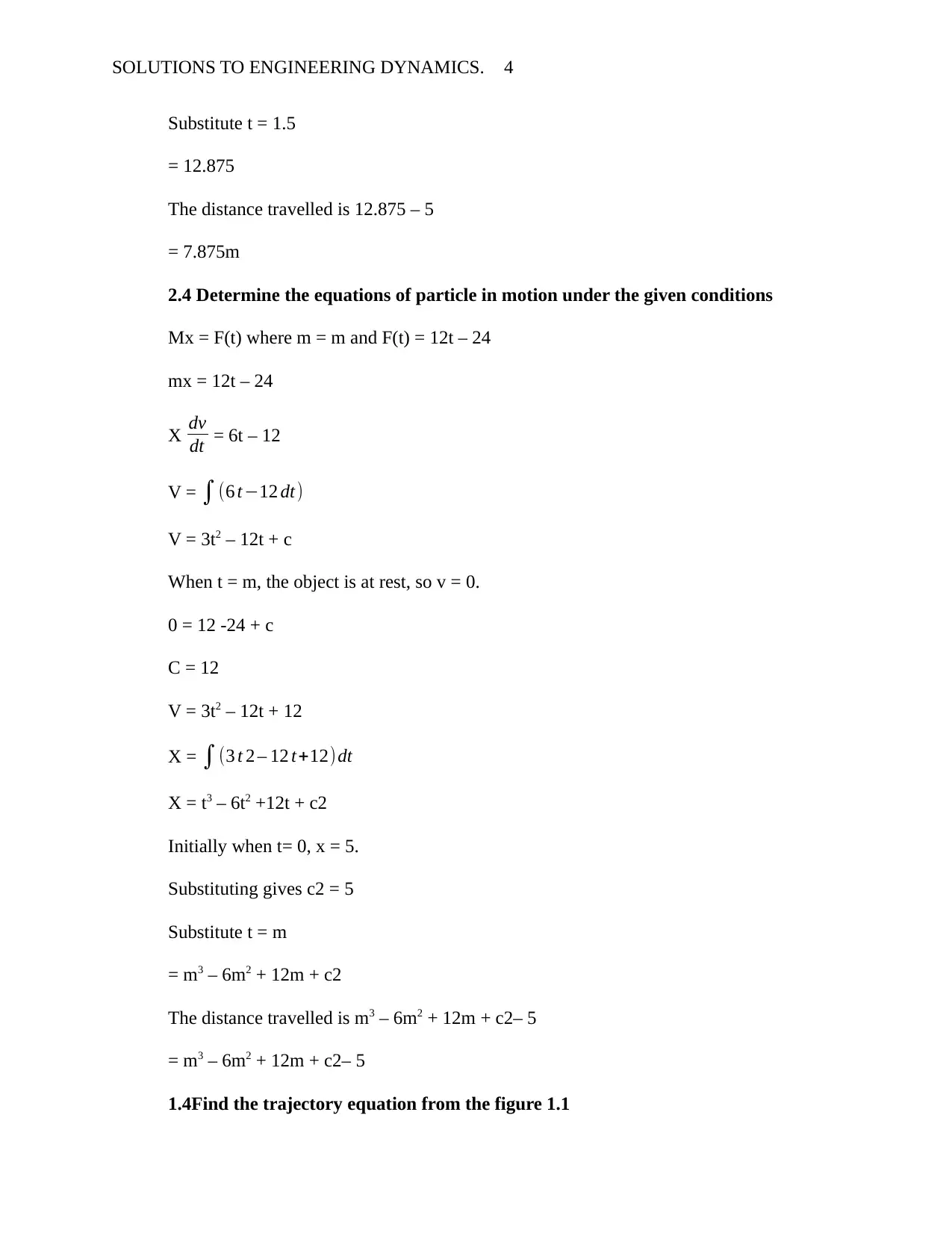
SOLUTIONS TO ENGINEERING DYNAMICS. 4
Substitute t = 1.5
= 12.875
The distance travelled is 12.875 – 5
= 7.875m
2.4 Determine the equations of particle in motion under the given conditions
Mx = F(t) where m = m and F(t) = 12t – 24
mx = 12t – 24
X dv
dt = 6t – 12
V = ∫(6 t−12 dt)
V = 3t2 – 12t + c
When t = m, the object is at rest, so v = 0.
0 = 12 -24 + c
C = 12
V = 3t2 – 12t + 12
X = ∫(3 t 2 – 12 t+12)dt
X = t3 – 6t2 +12t + c2
Initially when t= 0, x = 5.
Substituting gives c2 = 5
Substitute t = m
= m3 – 6m2 + 12m + c2
The distance travelled is m3 – 6m2 + 12m + c2– 5
= m3 – 6m2 + 12m + c2– 5
1.4Find the trajectory equation from the figure 1.1
Substitute t = 1.5
= 12.875
The distance travelled is 12.875 – 5
= 7.875m
2.4 Determine the equations of particle in motion under the given conditions
Mx = F(t) where m = m and F(t) = 12t – 24
mx = 12t – 24
X dv
dt = 6t – 12
V = ∫(6 t−12 dt)
V = 3t2 – 12t + c
When t = m, the object is at rest, so v = 0.
0 = 12 -24 + c
C = 12
V = 3t2 – 12t + 12
X = ∫(3 t 2 – 12 t+12)dt
X = t3 – 6t2 +12t + c2
Initially when t= 0, x = 5.
Substituting gives c2 = 5
Substitute t = m
= m3 – 6m2 + 12m + c2
The distance travelled is m3 – 6m2 + 12m + c2– 5
= m3 – 6m2 + 12m + c2– 5
1.4Find the trajectory equation from the figure 1.1
Paraphrase This Document
Need a fresh take? Get an instant paraphrase of this document with our AI Paraphraser
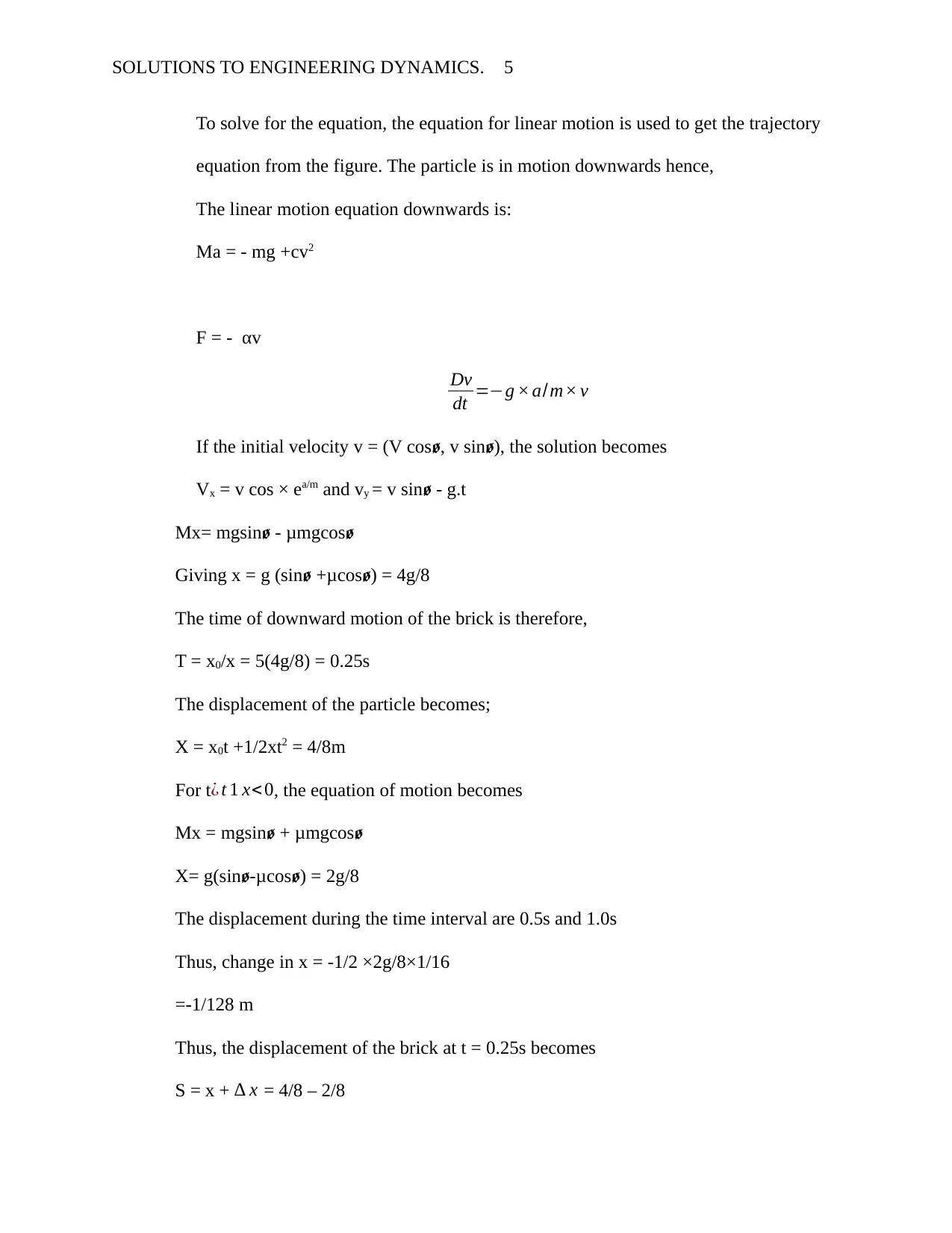
SOLUTIONS TO ENGINEERING DYNAMICS. 5
To solve for the equation, the equation for linear motion is used to get the trajectory
equation from the figure. The particle is in motion downwards hence,
The linear motion equation downwards is:
Ma = - mg +cv2
F = - αv
Dv
dt =−g × a/m× v
If the initial velocity v = (V cosꬾ, v sinꬾ), the solution becomes
Vx = v cos × ea/m and vy = v sin - g.tꬾ
Mx= mgsin - μmgcosꬾ ꬾ
Giving x = g (sin +μcos ) = 4g/8ꬾ ꬾ
The time of downward motion of the brick is therefore,
T = x0/x = 5(4g/8) = 0.25s
The displacement of the particle becomes;
X = x0t +1/2xt2 = 4/8m
For t¿ t 1 x< 0, the equation of motion becomes
Mx = mgsin + μmgcosꬾ ꬾ
X= g(sin -μcos ) = 2g/8ꬾ ꬾ
The displacement during the time interval are 0.5s and 1.0s
Thus, change in x = -1/2 ×2g/8×1/16
=-1/128 m
Thus, the displacement of the brick at t = 0.25s becomes
S = x + ∆ x = 4/8 – 2/8
To solve for the equation, the equation for linear motion is used to get the trajectory
equation from the figure. The particle is in motion downwards hence,
The linear motion equation downwards is:
Ma = - mg +cv2
F = - αv
Dv
dt =−g × a/m× v
If the initial velocity v = (V cosꬾ, v sinꬾ), the solution becomes
Vx = v cos × ea/m and vy = v sin - g.tꬾ
Mx= mgsin - μmgcosꬾ ꬾ
Giving x = g (sin +μcos ) = 4g/8ꬾ ꬾ
The time of downward motion of the brick is therefore,
T = x0/x = 5(4g/8) = 0.25s
The displacement of the particle becomes;
X = x0t +1/2xt2 = 4/8m
For t¿ t 1 x< 0, the equation of motion becomes
Mx = mgsin + μmgcosꬾ ꬾ
X= g(sin -μcos ) = 2g/8ꬾ ꬾ
The displacement during the time interval are 0.5s and 1.0s
Thus, change in x = -1/2 ×2g/8×1/16
=-1/128 m
Thus, the displacement of the brick at t = 0.25s becomes
S = x + ∆ x = 4/8 – 2/8
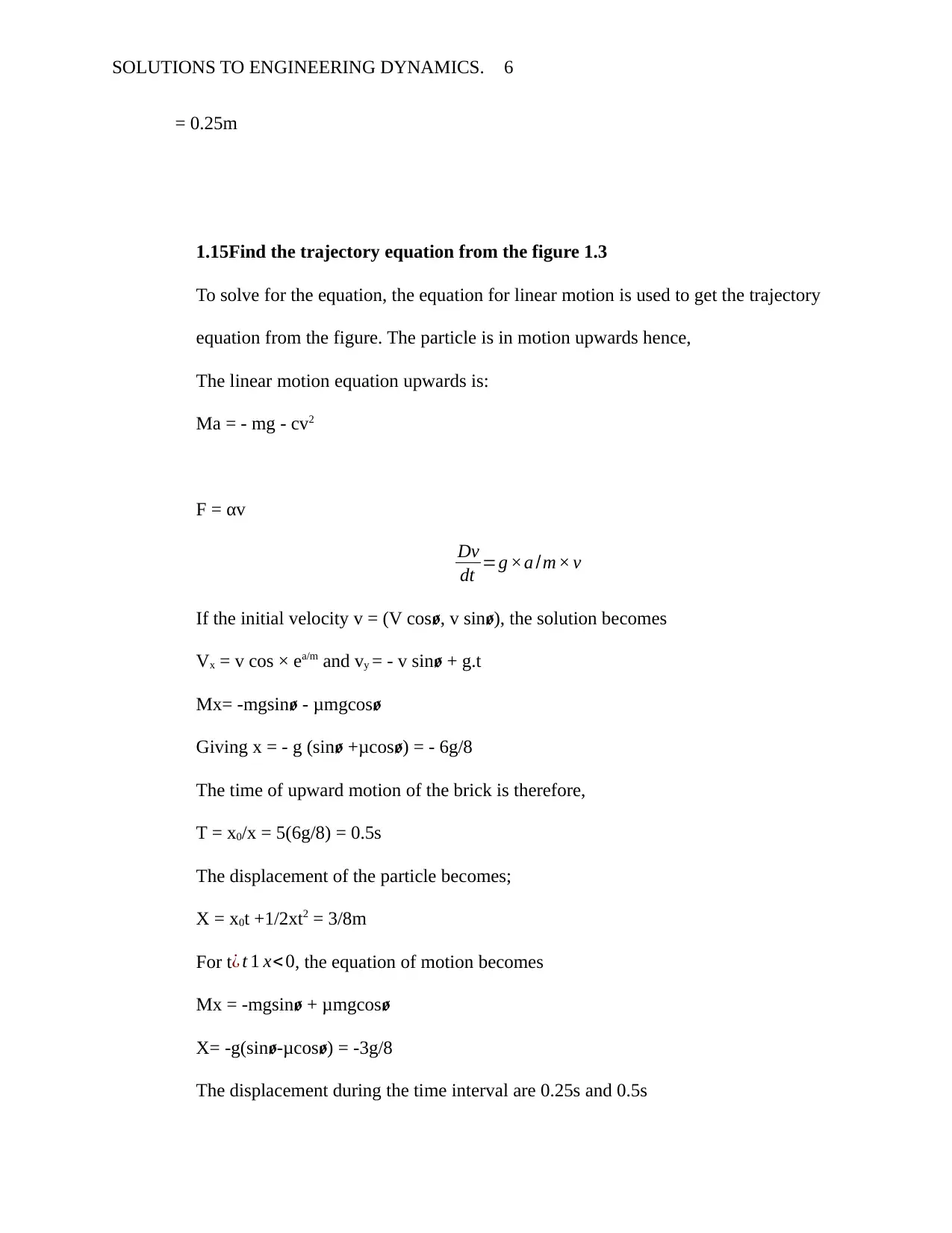
SOLUTIONS TO ENGINEERING DYNAMICS. 6
= 0.25m
1.15Find the trajectory equation from the figure 1.3
To solve for the equation, the equation for linear motion is used to get the trajectory
equation from the figure. The particle is in motion upwards hence,
The linear motion equation upwards is:
Ma = - mg - cv2
F = αv
Dv
dt =g ×a /m× v
If the initial velocity v = (V cosꬾ, v sinꬾ), the solution becomes
Vx = v cos × ea/m and vy = - v sin + g.tꬾ
Mx= -mgsin - μmgcosꬾ ꬾ
Giving x = - g (sin +μcos ) = - 6g/8ꬾ ꬾ
The time of upward motion of the brick is therefore,
T = x0/x = 5(6g/8) = 0.5s
The displacement of the particle becomes;
X = x0t +1/2xt2 = 3/8m
For t¿ t 1 x< 0, the equation of motion becomes
Mx = -mgsin + μmgcosꬾ ꬾ
X= -g(sin -μcos ) = -3g/8ꬾ ꬾ
The displacement during the time interval are 0.25s and 0.5s
= 0.25m
1.15Find the trajectory equation from the figure 1.3
To solve for the equation, the equation for linear motion is used to get the trajectory
equation from the figure. The particle is in motion upwards hence,
The linear motion equation upwards is:
Ma = - mg - cv2
F = αv
Dv
dt =g ×a /m× v
If the initial velocity v = (V cosꬾ, v sinꬾ), the solution becomes
Vx = v cos × ea/m and vy = - v sin + g.tꬾ
Mx= -mgsin - μmgcosꬾ ꬾ
Giving x = - g (sin +μcos ) = - 6g/8ꬾ ꬾ
The time of upward motion of the brick is therefore,
T = x0/x = 5(6g/8) = 0.5s
The displacement of the particle becomes;
X = x0t +1/2xt2 = 3/8m
For t¿ t 1 x< 0, the equation of motion becomes
Mx = -mgsin + μmgcosꬾ ꬾ
X= -g(sin -μcos ) = -3g/8ꬾ ꬾ
The displacement during the time interval are 0.25s and 0.5s
⊘ This is a preview!⊘
Do you want full access?
Subscribe today to unlock all pages.

Trusted by 1+ million students worldwide
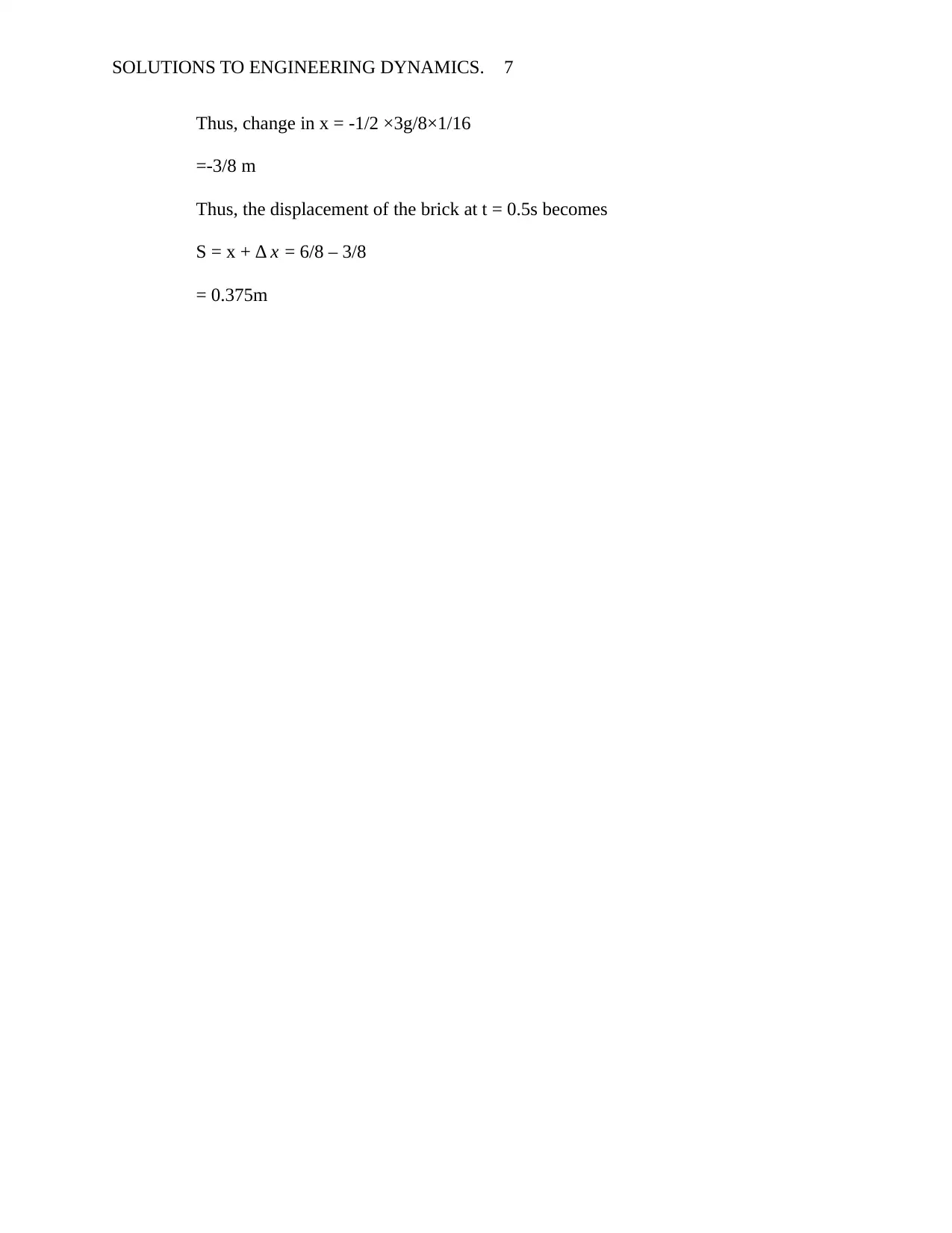
SOLUTIONS TO ENGINEERING DYNAMICS. 7
Thus, change in x = -1/2 ×3g/8×1/16
=-3/8 m
Thus, the displacement of the brick at t = 0.5s becomes
S = x + ∆ x = 6/8 – 3/8
= 0.375m
Thus, change in x = -1/2 ×3g/8×1/16
=-3/8 m
Thus, the displacement of the brick at t = 0.5s becomes
S = x + ∆ x = 6/8 – 3/8
= 0.375m
Paraphrase This Document
Need a fresh take? Get an instant paraphrase of this document with our AI Paraphraser
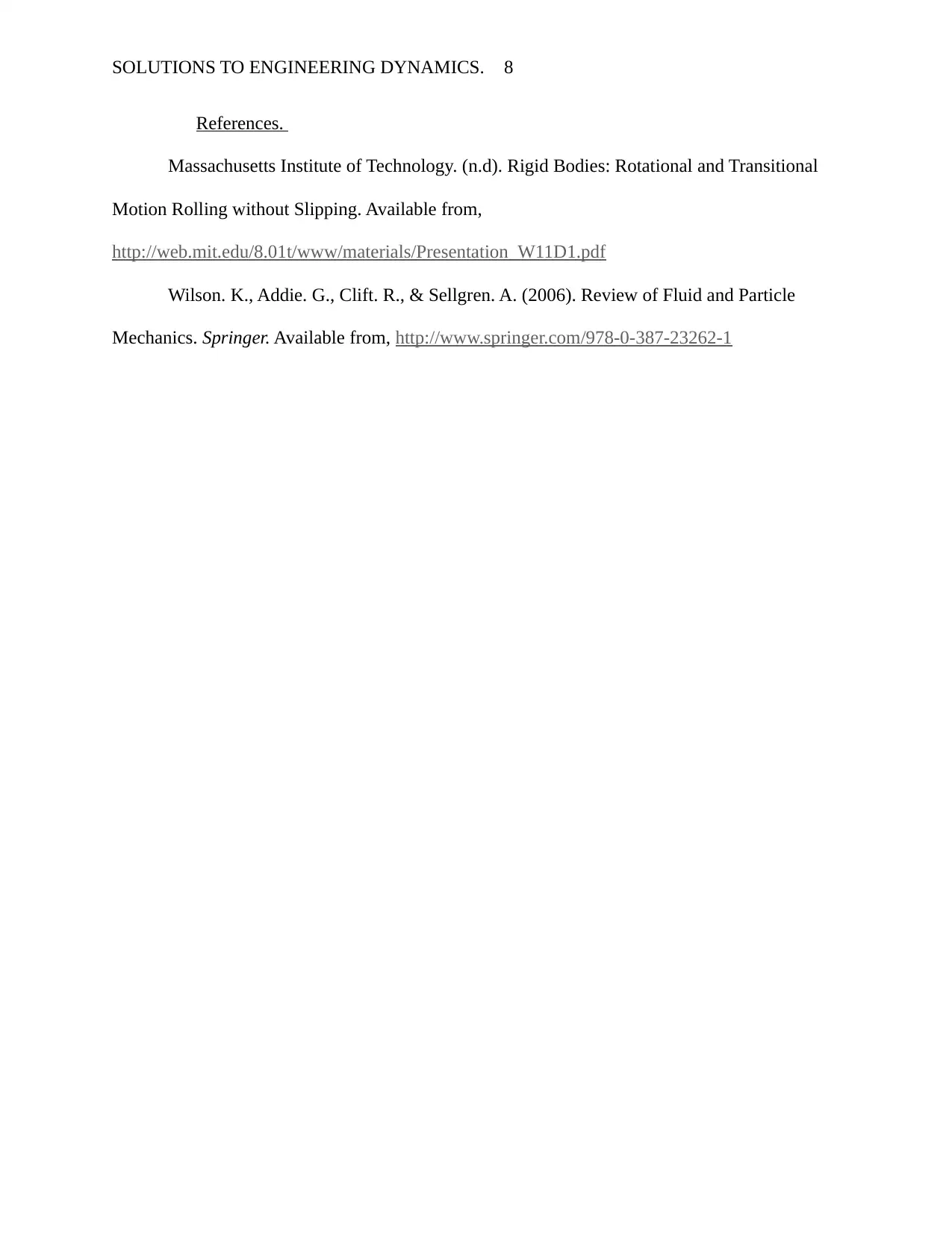
SOLUTIONS TO ENGINEERING DYNAMICS. 8
References.
Massachusetts Institute of Technology. (n.d). Rigid Bodies: Rotational and Transitional
Motion Rolling without Slipping. Available from,
http://web.mit.edu/8.01t/www/materials/Presentation_W11D1.pdf
Wilson. K., Addie. G., Clift. R., & Sellgren. A. (2006). Review of Fluid and Particle
Mechanics. Springer. Available from, http://www.springer.com/978-0-387-23262-1
References.
Massachusetts Institute of Technology. (n.d). Rigid Bodies: Rotational and Transitional
Motion Rolling without Slipping. Available from,
http://web.mit.edu/8.01t/www/materials/Presentation_W11D1.pdf
Wilson. K., Addie. G., Clift. R., & Sellgren. A. (2006). Review of Fluid and Particle
Mechanics. Springer. Available from, http://www.springer.com/978-0-387-23262-1
1 out of 8
Related Documents
Your All-in-One AI-Powered Toolkit for Academic Success.
+13062052269
info@desklib.com
Available 24*7 on WhatsApp / Email
![[object Object]](/_next/static/media/star-bottom.7253800d.svg)
Unlock your academic potential
Copyright © 2020–2025 A2Z Services. All Rights Reserved. Developed and managed by ZUCOL.





